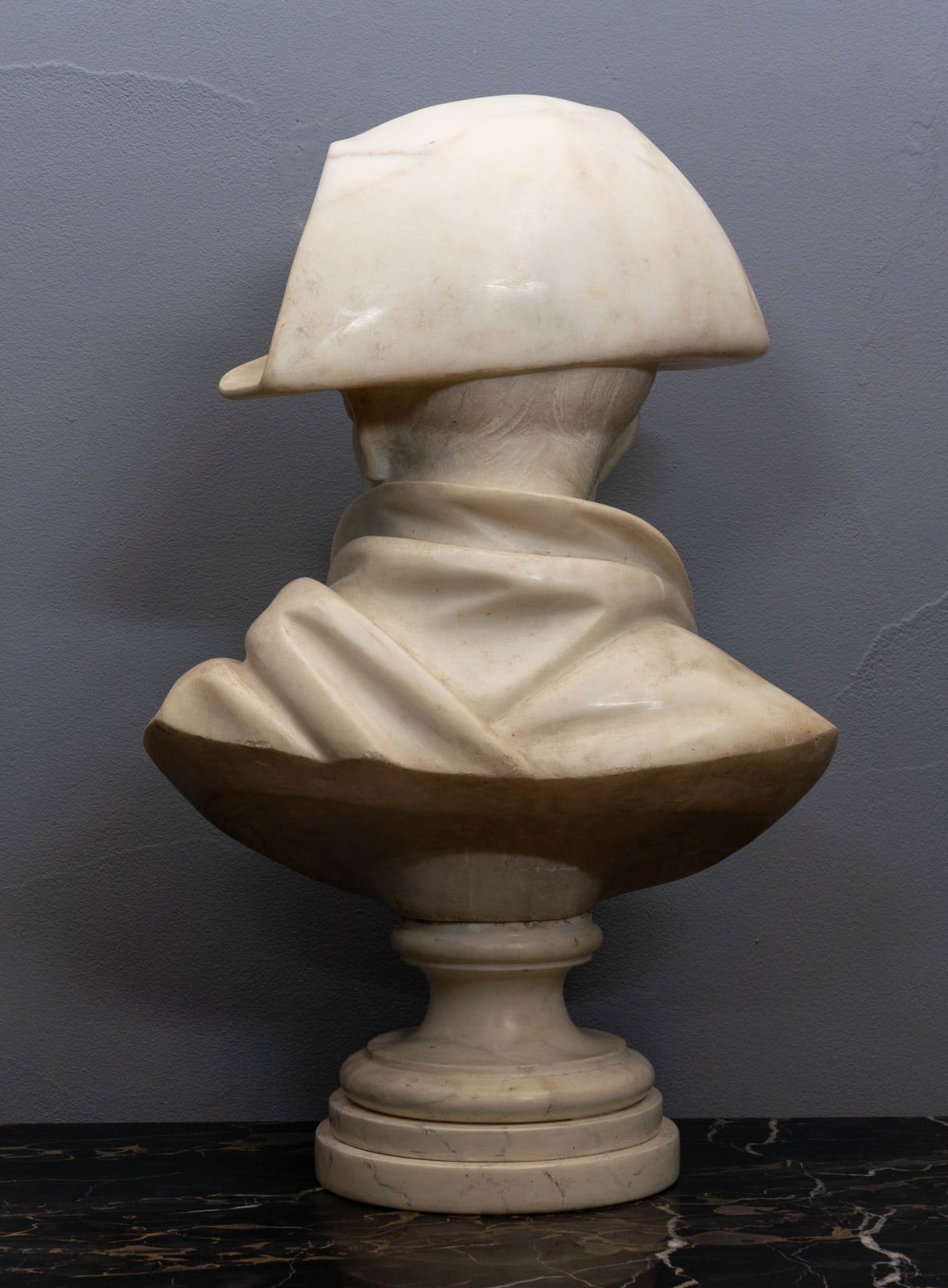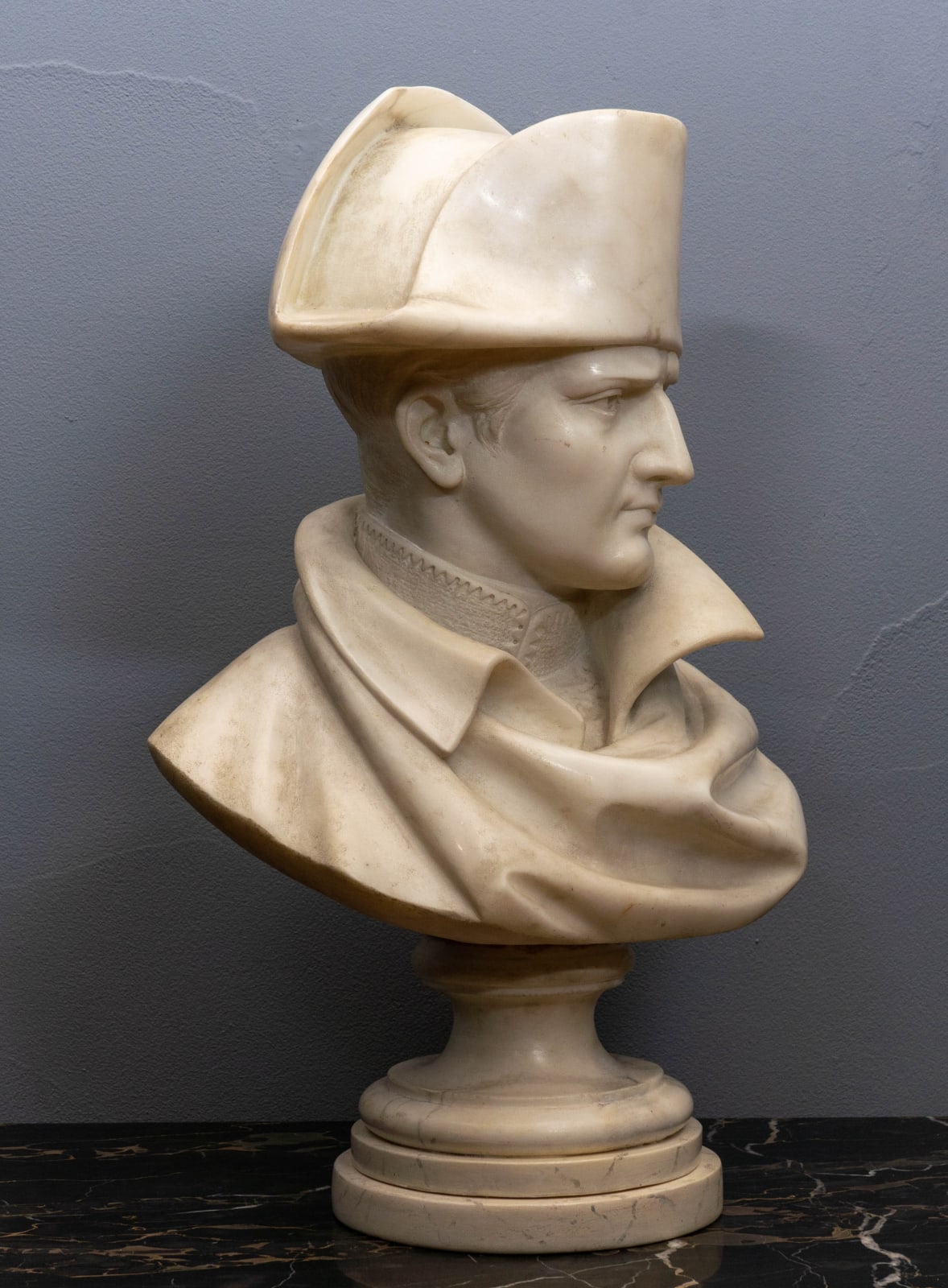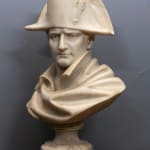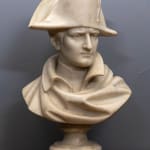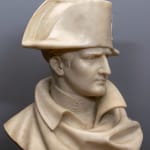A WHITE MARBLE BUST OF NAPOLEON BONAPARTE, Paris, date circa 1810-20
Height: 60cm
Further images
An extremely fine white marble bust of Napoleon Bonaparte wearing his distinctive bicorne hat with cockade, his cloak over his military uniform and looking slightly downward, the head and shoulder statue raised on a circular stepped base
Paris, date circa 1810-20
Height 60 cm.
This superb white marble bust of Napoleon Bonaparte, portrays him as a young military leader, probably soon after he was crowned Napoleon I Emperor of France in late 1804. Possibly the most famous and powerful self-made man in history, he was born on 15th August 1759 at Ajaccio, the son of a noble Corsican with little fortune but a large family to provide for. Despite his unpromising beginnings, Napoleon was to become the world’s most powerful leader through a combination of talent, determination, energy and good fortune. Having attended military school at Brienne and then the military school in Paris he rose through the ranks to become a Brigadier-General and soon after in 1794, inspector of artillery in the Army of the Alps. When in 1795 a royalist revolt in Paris threatened to overthrow the government, it fell to Napoleon to save the Republic. Although his men were massively outnumbered, Napoleon and the Republicans emerged the victors. As such his exploits won him ever greater standing among the politicians running the new regime known as the Directory. Immediately after his marriage in 1796 to the beautiful Joséphine, widow of Alexandre de Beauharnais (who died at the guillotine during the Reign of Terror) he left home to take up his new post as Commander in Chief of the Army of Italy. In this he proved remarkably successful, transforming an inefficient army into a powerful fighting force.
1798 saw the first of his Nile Campaigns, followed by his return to Paris in 1799 when he was appointed First Consul and as such was now leader of the greatest power in Europe. Despite a period of relative stability, Napoleon was ever aware of pro-royalist uprisings and thus decided to formalise his leadership by crowning himself Emperor of France in December 1804. Napoleon then embarked upon a string of military victories beginning in the Battle of Austerlitz in 1805 where he defeated a much larger Austrian and Russian force. Although France was then defeated in 1805 by its old enemy Britain at the Battle of Trafalgar, Napoleon’s empires continued to swell to include Holland, parts of Germany and almost all of Italy.
Like Henry VIII of England, Napoleon desired a male heir to inherit his empire. Thus in 1810 he divorced Joséphine, remarried Marie-Louise, daughter of the Austrian emperor Francis I and the following year had a son who was titled the King of Rome. 1812 saw his invasion of Russia and overthrow of Moscow but then on their return his troops were eventually overcome, exacerbated by the bitter winter weather and lack of supplies. Broken in the east and with Austrian and Prussian re-entry into the war, Napoleon was driven from central Europe. His empire was crumbling around him. After the allied armies advanced on Paris in March 1814, Napoleon was forced to abdicate; he was confined to the island of Elba and Louis XVIII was crowned King of France. All seemed lost yet less than a year after his exile, he had escaped Elba and was once more back in Paris. From there he and his army invaded Belgium, hoping to capture Brussels and drive a wedge between the advancing British and Prussian forces gathering on his borders. On 18th June 1815, Napoleon was defeated by the Duke Wellington and his allies at the Battle of Waterloo. Three days later he abdicated for the second time and thereafter was banished to the small British territory of Saint Helena in the South Atlantic where he remained until his death in 1821.
Despite his ultimate demise, Napoleon was a great politician and military leader. He was also a champion of the arts who recreated a new style largely inspired by antiquity, known as the Empire, that reflected his own power and authority. Unsurprisingly numerous likenesses of him were made, counting among them paintings by leading artists of the day. Among the best known portraits were those by Antoine Jean Gros, who portrayed him as a young military leader while Jean-Auguste-Dominique Ingres and François Pascal Simon Baron Gérard both painted him dressed in his coronation robes. On the other hand, Jacques-Louis David painted the heroic Napoleon on horseback crossing the Alps and on another occasion standing in his library. Numerous and varied sculptures of Napoleon was also made in marble or bronze. Perhaps the best known marble busts were those by Antoine-Denis Chaudet, Jean-Antoine Houdon and especially Antonio Canova, who on various occasions apotheosized Napoleon, likening him to a Roman Emperor. In contrast the present marble bust portrays Napoleon as a military leader wearing his army uniform, especially his famous bicorn hat. Napoleon is said to have owned 120 of these black felt hats with their red, white and blue cockade which were made by the Parisian hat makers Poupart et Cie, who had premises in what is now the Palais-Royal. The convention of the time was to wear such hats with their corners pointing forward and back. However, Napoleon wore his sideways to ensure he was instantly identifiable on the battlefield.
A number of other marble busts of Napoleon wearing his hat are known, of which one of the closest examples is housed in the Villa dei Mulini (now a national museum) at Portoferraio on the Italian isle of Elba, where Napoleon spent 300 days in exile before returning to fight at the Battle of Waterloo. Another comparable bust, again unsigned, but of equally superior quality was gifted by Mr. George A. Zabriskie to the New York Historical Society in 1939. There are also a number of bronze busts of extremely similar design, of which some bear the signature of ‘A Canova’ beside the later Paris foundry stamp of J. B. Déposée. It is believed that they, like the present bust, are based on an original marble by the leading Neo-classical sculptor Antonio Canova, for although Canova is not necessarily recorded as having modelled the Emperor wearing his hat, the intense face, furrowed brow and downward looking eyes that loom from his most important official images of Napoleon is very similar to the present bust. Canova’s bust was reproduced on numerous occasions at his studio while the only known example to have been carved by Canova himself is now at Chatsworth House in Derbyshire. The bust was in fact derived from an earlier colossal full-length statue (1803-6) portraying Napoleon as Mars Pacificus, which Napoleon famously rejected on account of its nudity. Now housed at Apsley House, London, the latter provided the model for Canova’s simpler bust as well as many latter reproductions by others at his Roman studio as well as at a business concern set up by Napoleon’s sister Elisa Bonaparte Baciocchi at the Carrara marble quarries. It should also be noted that the present marble shares similarities with the head and shoulders of a later full length bronze statue of Napoleon by Charles-Marie-Emile Seurre (1798-1858) which originally surmounted the Vendôme Column in Paris and was commissioned by the Ministry of the Interior in June 1831. Such was Napoleon’s renown that his likeness continued to be reproduced in marble and bronze throughout his life and well after his death.


